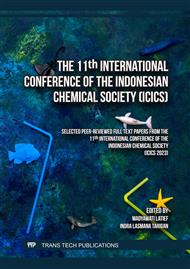[1]
H. Yang, M. Lu, D. Chen, R. Chen, L. Li, and W. Han, "Efficient and rapid removal of Pb2+ from water by magnetic Fe3O4@MnO2 core-shell nanoflower attached to carbon microtube: Adsorption behavior and process study," J. Colloid Interface Sci., vol. 563, p.218–228, 2020.
DOI: 10.1016/j.jcis.2019.12.065
Google Scholar
[2]
M. Vithanage et al., "Deposition of trace metals associated with atmospheric particulate matter: Environmental fate and health risk assessment," Chemosphere, vol. 303, no. P3, p.135051, 2022.
DOI: 10.1016/j.chemosphere.2022.135051
Google Scholar
[3]
P. Liu, Q. Wu, W. Hu, K. Tian, B. Huang, and Y. Zhao, "Effects of atmospheric deposition on heavy metals accumulation in agricultural soils: Evidence from field monitoring and Pb isotope analysis," Environ. Pollut., vol. 330, no. February, p.121740, 2023.
DOI: 10.1016/j.envpol.2023.121740
Google Scholar
[4]
Anonymous, "WHO guidance to reduce illness due to lead exposure," WHO.
Google Scholar
[5]
A. M. Bergquist, J. K. Choe, T. J. Strathmann, and C. J. Werth, "Evaluation of a hybrid ion exchange-catalyst treatment technology for nitrate removal from drinking water," Water Res., vol. 96, p.177–187, 2016.
DOI: 10.1016/j.watres.2016.03.054
Google Scholar
[6]
T. A. Kurniawan, G. Y. S. Chan, W. H. Lo, and S. Babel, "Physico-chemical treatment techniques for wastewater laden with heavy metals," Chem. Eng. J., vol. 118, no. 1–2, p.83–98, 2006.
DOI: 10.1016/j.cej.2006.01.015
Google Scholar
[7]
P. Y. Lin et al., "Preparation of vaterite calcium carbonate granules from discarded oyster shells as an adsorbent for heavy metal ions removal," Chemosphere, vol. 254, p.126903, 2020.
DOI: 10.1016/j.chemosphere.2020.126903
Google Scholar
[8]
H. Esmaeili, S. Tamjidi, and M. Abed, "Removal of cu(Ii), co(ii) and pb(ii) from synthetic and real wastewater using calcified Solamen Vaillanti snail shell," Desalin. Water Treat., vol. 174, p.324–335, 2020.
DOI: 10.5004/dwt.2020.24880
Google Scholar
[9]
S. Shahzad, N. Shahzad, A. Yaqub, U. Sadiq, U. Ahmad, and M. Hussain, "Removal of Heavy Metal Lead (Pb) (Ii) By Biosorption Process Using Paper Shell Mussel (Anodontoides Ferussacianus)," World J. Pharm. Med. Res., vol. 3, no. 6, p.281–288, 2017.
DOI: 10.9734/jabb/2016/25229
Google Scholar
[10]
J. Zhang, X. Hu, K. Zhang, and Y. Xue, "Desorption of calcium-rich crayfish shell biochar for the removal of lead from aqueous solutions," J. Colloid Interface Sci., vol. 554, p.417–423, 2019.
DOI: 10.1016/j.jcis.2019.06.096
Google Scholar
[11]
W. D. Ivontianti, S. Khairi, R. Devitasari, and Yusup, "Pmanfataan Cangkang Keong Susuh Kura (Sulcospira Testudinaria) Sebagaie Adsorben Untuk Menyerap Logam Besi (Fe) di Perairan dengan Kajian Variasi Suhu Kalsinasi Adsorben," J. Teknol. Lingkung. Lahan Basah, vol. 10, no. 1, p.38–47, 2022.
DOI: 10.26418/jtllb.v10i1.51649
Google Scholar
[12]
S. Lailiyah, D. Arfiati, A. M. S. Hertika, N. D. K. Arum, and C. B. Noviya, "The effectiveness of filopaludina javanica and sulcospira testudinaria in reducing organic matter in catfish (clarias sp.) aquaculture wastewater," J. Ilm. Perikan. dan Kelaut., vol. 13, no. 1, p.106–113, 2021.
DOI: 10.20473/jipk.v13i1.23085
Google Scholar
[13]
S. A. Mahmoud, A. S. Orabi, L. I. Mohamedein, K. M. El-Moselhy, and E. M. Saad, "Eco-friend shellfish powder of the mussel Brachidontes variabilis for uptake lead (II) ions," Biomass Convers. Biorefinery, vol. 14, no. 15, p.17201–17218, 2024.
DOI: 10.1007/s13399-023-03950-2
Google Scholar
[14]
B. S. Nugroho, D. Wahyuni, A. Asri, and U. Mustafa, "Effect of Calcination Temperature on the Powder of Freshwater Snail Shells (Sulcospira testudinaria) Properties," Positron, vol. 13, no. 2, p.158, 2023.
DOI: 10.26418/positron.v13i2.70055
Google Scholar
[15]
M. Karaoui, R. Hsissou, M. Alami, and M. Assouag, "Physicochemical characterization of snail shells powder prepared by mechanochemical processes and thermal treatment," J. Met. Mater. Miner., vol. 33, no. 2, p.139–147, 2023.
DOI: 10.55713/jmmm.v33i2.1700
Google Scholar
[16]
Q. Wang, F. Jiang, X. K. Ouyang, L. Y. Yang, and Y. Wang, "Adsorption of pb(Ii) from aqueous solution by mussel shell-based adsorbent: Preparation, characterization, and adsorption performance," Materials (Basel)., vol. 14, no. 4, p.1–17, 2021.
DOI: 10.3390/ma14040741
Google Scholar
[17]
K. Sbissi, V. Collière, M. L. Kahn, E. K. Hlil, M. Ellouze, and F. Elhalouani, "Fe doping effects on the structural, magnetic, and magnetocaloric properties of nano-sized Pr0.6Bi0.4Mn1−xFexO3 (0.1 ≤ x ≤ 0.3) manganites," J. Nanostructure Chem., vol. 5, no. 3, p.313–323, 2015.
DOI: 10.1007/s40097-015-0163-0
Google Scholar
[18]
F. Ahmadi and H. Esmaeili, "Chemically modified bentonite/Fe3O4 nanocomposite for Pb(II), Cd(II), and Ni(II) removal from synthetic wastewater," Desalin. Water Treat., vol. 110, no. 22228, p.154–167, 2018.
DOI: 10.5004/dwt.2018.22228
Google Scholar
[19]
S. Tamjidi and H. Esmaeili, "Chemically Modified CaO/Fe 3 O 4 Nanocomposite by Sodium Dodecyl Sulfate for Cr(III) Removal from Water," Chem. Eng. Technol., vol. 42, no. 3, p.607–616, 2019.
DOI: 10.1002/ceat.201800488
Google Scholar
[20]
A. D. Alsulali, A. A. Refaie, and H. A. Garcia, "Adsorption capacity of activated carbon derived from date seeds: Characterization, optimization, kinetic and equilibrium studies,". Chemospher..,. vol. 5, no. 3, p.1–10, 2023
DOI: 10.1016/j.chemosphere.2022.137554
Google Scholar
[21]
Chen, SL., Cao, CY., Long, WL. et al., "Adsorption performance of Cadmium (II) on calcined hydrotalcite,". Res Chem Intermed,. vol. 5, no. 3, pp.2409-2426, 2024
DOI: 10.1007/s11164-024-05246-0
Google Scholar


